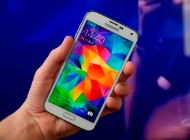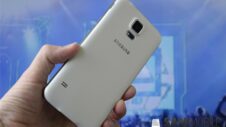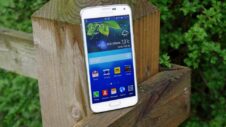Today, the Galaxy S5 became available for purchase in more than 125 countries around the world. We've been working on a review of the device for some time now, but we would like to give our readers a quick preview of what they can expect from Samsung's latest flagship. Like we said in our hands-on review during the phone's announcement, the Galaxy S5 is the most complete Samsung smartphone to come out, so continue reading to find out what makes it tick.

In terms of design, at least from the front, you would be hard pressed to differentiate the S5 from the Galaxy S4, but that's not exactly a bad thing when you consider the beautiful display from the S4 has been further enhanced, with the same image quality with high-contrast colors and sharp viewing angles offering a display experience not found on other companies' flagships (though that's not exactly a comparison we should be doing, as only Samsung uses AMOLED displays.) The screen has grown in size by a mere 0.1-inch to 5.1-inch, which means the Full HD (1920×1080) resolution makes it extremely sharp. The phone is also water-resistant with IP67 certification, but the overall size has remained mostly the same as the Galaxy S4's.

Below the display, there's Samsung's trademark hardware home button, which now acts as a fingerprint scanner. Samsung's implementation of the scanner is different from Apple's: a user must swipe his/her finger over the home button, covering the entire surface of the button. Apart from unlocking the phone, the fingerprint scanner can be used to make PayPal payments, and access a special mode that includes a few private files you don't want anyone else to see. It's quite accurate at detecting your fingerprint, and works pretty fast – people had thought Samsung would mess up its implementation, but it's great to see that hasn't been the case.


Of course, as has been said a lot in the media, the back of the Galaxy S5 brings something new to the popular Galaxy S lineup – instead of the hated and slippery glossy plastic, the back cover is now faux leather with a dimpled design that feels great in the hand, and contributes to the convenience of using the phone considerably. Color options include black, white, blue and gold for the back, and while it may not look that good in pictures, the blue version was rather stunning in person. Overall, the design is now better, and while we still wish Samsung would adopt a new design language for its flagships, we feel the overall design is at a very mature stage with the fifth-generation.


Internally, the Galaxy S5 is as advanced as one would hope a 2014 flagship to be – there's a 2.5GHz Snapdragon 801 processor, 2,800 mAh battery, a 16-megapixel camera with a focus on features like fast autofocus and enhanced HDR photography, and the latest version of Android with a newer version of Samsung's TouchWiz UX (more on that below.) However, there are a few odd downgrades compared to the Galaxy Note 3 from last year – there's only 2GB of RAM instead of 3, and Samsung has gone back to putting only 16GB of internal storage on the base model. These are rather adequate, true (especially the lower amount of RAM, as the S5 won't have the additional features found on the Note series, like Air Command or other stylus-specific features), but it's still an odd move to see Samsung's newer flagship taking a step down in some areas compared to the previous flagship.


SOFTWARE
With the Galaxy S5, Samsung has focused on streamlining its software and introducing only a few but very useful features. While a lot of the interface has remained the same, there are quite a few changes in some areas. The notifications menu has been redesigned (it's similar to the one on Samsung's new PRO line of tablets) with rounder, flatter icons that look pretty good, some apps including S Health, Gear Manager and others have been given a flatter, more attractive look, and even the recent apps screen has been given a makeover (a rather ugly one, if we're honest.) Everything is faster and lighter as well.
In terms of features, there's Kids Mode, that allows you to lock things down and customize a separate environment for your kids, like limiting the number of people they can call or the apps they can use, with a dedicated app store for both fun and learning for the little ones. But even more useful is Ultra Power Saving Mode – enabling this mode will disable the color output of the display, turn off data when the screen is off, and turn off location services to save battery, and can, in theory, offer up to a day of usage in just 10 percent of battery. Then there's Download Booster, which combines a Wi-Fi and LTE connection for faster downloads of files.
Then there are new camera modes, including one that allows to take a photo and refocus it later on. Overall, everything is smoother, faster and more efficient; as mentioned above, Samsung has gone for minimalism this time, and we'll have more details in our full review that will be up very soon.

CONCLUSION
Overall, the Galaxy S5 is more of an iterative upgrade than a major one, and Samsung has done a great job improving on every weak aspect from existing devices. The camera can capture more detail and offers better low-light images, the phone is more rugged and waterproof, the software is faster and visually improved, and the fingerprint scanner is a unique feature standing out among the competition. The Galaxy S5 is a great flagship smartphone that you really should consider when you're out looking for a new phone, and we'll be going into full detail about its pros and cons in our upcoming review.







